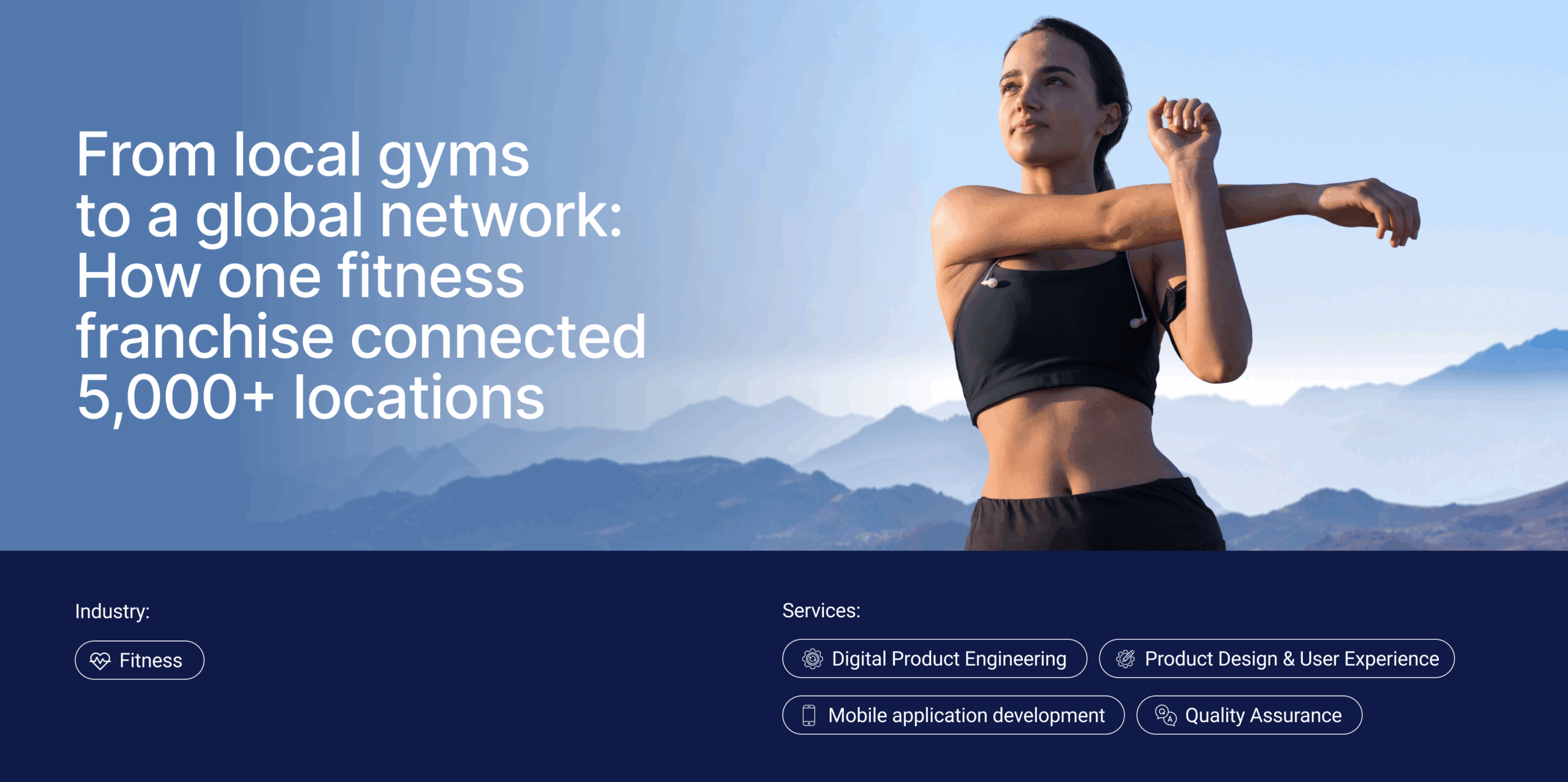
Scalability and performance are the cornerstones of future-proof software that drives business growth and innovation. By seamlessly combining DevOps and Agile methodologies, along with test-driven development and security-first standards, businesses can create solutions built to last. Dive into our comprehensive guide for a 360-degree exploration of what it takes to design and develop software that stands the test of time.
Future-proof software development is all about designing software that stands the test of time and remains relevant, functional, and adaptable to technological trends and changing business requirements. When done right, the application’s architecture can be scaled or upgraded easily without costly rewrites, system replacements, or major modifications.
Built upon arbitrary design patterns, neglecting such industry standards as modularity and microservices, legacy applications can become obsolete. The only solution then is to replace the outdated software with a new solution.
Netflix has foreseen this in 2021-2022 when they migrated to a microservices-based cloud infrastructure, which allowed them to scale globally and adapt to changing content delivery technologies. Read on to follow in their path and learn more about future-proof software development.

Emerging Trends in Future-Proofing Software
Our tech team at Coherent closely follows and stays on the pulse of every new drift in software development. Here are the key trends we see shaping the industry at the moment:
Embracing AI tools
AI tools are creeping into all stages of software development, from coding to project management, DevOps, security, and quality assurance. They automate tasks and enhance practices.
Most noticeable are code completion solutions like GitHub Copilot. A 2024 survey found that 61% of organizations use AI for code generation and 29.3% for code optimization. Copilot generates code blocks and provides real-time suggestions, saving time and allowing for more strategic design thinking.
Cloud-Native and Serverless Architectures
Industry-specific cloud platforms that combine SaaS, PaaS, and IaaS now dominate enterprise markets, from finance to healthcare. The global software market exceeded $700 billion in 2024, driven largely by cloud computing.
Serverless applications are the new black. It’s a future-proof architecture where developers no longer need to manage scaling, servers, or resource allocation. Cloud providers handle these aspects. With hybrid, multi-cloud environments, businesses can freely innovate and enhance customer experiences.
Low-Code/No-Code Platforms
Low-code/no-code (LCNC) platforms give the power of creating software to people with limited tech expertise. Businesses can build solutions faster at a fraction of the cost.
The global market for low-code and no-code technologies is expected to exceed $27 billion after 2024.
Regular workflows also benefit from these tools. With code/no code tools, designers can instantly create code to support their UX designs, and developers can work to enhance the components.
DevSecOps and Cybersecurity
Software becomes more vulnerable by the hour, with a 600% rise in phishing schemes in recent years and ransomware occurrences every 11 seconds. To counter this, DevSecOps integrates security early in development, reducing the risks. Key measures include using vulnerability management systems (VMSs) and configuration management platforms (CMPs).
Security standards like OWASP, NIST, GDPR, HIPAA, and CCPA are becoming ubiquitous. Granularity and interoperability are the two key elements in cybersecurity frameworks, with Zero-Trust and cybersecurity Mesh architecture at the helm.
Platform Engineering and QA Automation
Platform engineering provides developers with custom tools they need to build, test, and deploy software. Software development teams are wise to introduce and customize their very own toolkits, coding standards, project management practices, and software delivery routines.
For instance, it’s common practice to build improved interfaces on top of the popular Kubernetes containerization platform.
Meanwhile, QA automation enables faster and more frequent releases without sacrificing quality. Surveys show that organizations investing in QA automation reported significant ROI improvements, with over 3000 QA teams showing increased satisfaction and return on investments in automated testing.

Principles of Future-Proof Software Architecture
Expanding a solution to accommodate millions of new users while integrating new features is not an easy task. Especially when your plan is to seamlessly scale operations, enhance performance, and stay agile in today’s dynamic global market. Companies that build software based on these principles are on the right track.
Modularity and Microservices
Modern future-proof software architecture favors microservices over monolithic applications. The system is usually broken into independent, loosely coupled services. This way each part of the app can be built, tested, and deployed separately. It brings forth much faster development cycles and easier software updates.
Another way to achieve this flexibility is having modular monolith architecture which combines the benefits of microservices with the robustness of full monolithic deployment. A modular monolith solution is easier to maintain and can gradually transition to microservices as development progresses.
Scalability and Performance
With future-proof software, you can easily change the solution’s functionality or scale it to fit the business’s new depth of operations.
Key strategies for building scalable software include database partitioning, sharding, and replication across multiple servers, along with using NoSQL databases for handling large-scale unstructured data.
At the same time, to improve system performance, developers usually employ efficient server-side and client-side data caching mechanisms.
Decoupling and Abstraction
Abstraction in software design enables the application to grow by adding or modifying components without disrupting the solution as a whole or hurting other features and functionality.
It’s achieved by using friendly coding interfaces that isolate the purpose of the functionality from its specific implementation.
The software usually consists of many loosely coupled packages. And when the requirements change, instead of going through the whole codebase, all you need to do is apply these few minor modifications to specific system components.
Cloud-Native Architectures
Cloud-native development goes beyond simply moving applications to managed AWS or Google infrastructure. It’s about building solutions straight in the cloud, leveraging all of the cloud computing capabilities, and making apps cloud-compatible by design.
Some of the perks that cloud services provide are pre-baked images, databases, developer tools, simplified microservice orchestration, back-end software management, and much more.
Using managed services from cloud vendors minimizes startup time while enabling DevOps practices, continuous delivery, and seamless integration with emerging technologies.
Best Practices for Future-Proof Development
Whether you’re working on cutting-edge applications or maintaining current enterprise systems, we suggest these best practices for crafting software that stands the test of time:
Test-Driven Development (TDD) and Continuous Integration/Delivery (CI/CD)
Modern software development relies on automated testing strategies to maintain code reliability. Test-driven development guides developers to write tests first before starting development. The result is comprehensive test coverage and modularity laid into the system’s code.
This approach integrates seamlessly with CI/CD pipelines, where code changes trigger automated tests before deployment. Using established automation frameworks enables efficient testing across different platforms, while quick feedback loops help developers address issues early.
Agile and DevOps
Agile methodology and DevOps create a synergistic approach to software development, emphasizing continuous improvement and efficiency. While Agile focuses on iterative development, collaboration, and rapid customer feedback, DevOps eliminates silos between development and operations teams.
Together, they enable automated processes and quick service delivery. It inspires a culture of continuous improvement, where development, operations, QA, and security teams collaborate seamlessly to deliver high-quality future-proof software.
Documentation and Code Readability
Effective code documentation goes beyond mere comments to create a comprehensive knowledge base for teams. It requires clear explanations of code purpose, functionality, and implementation in accessible language.
Modern documentation tools enable interactive guides and API references, while established coding standards ensure consistency. Keeping centralized knowledge repositories, including detailed README files, works great for easier onboarding and long-term maintenance.
Security by Design
Comprehensive security requires a multi-faceted approach right from the start of development. Key practices here include input validation, encryption for data protection, and mindful API integrations. Threat modeling is a powerful proactive method that provides ongoing security assessment throughout the development lifecycle.
For future-proof and reliable software, development choices should always be guided by security-by-design principles set in standards like OWASP. Using modern tools like memory-safe languages, SAST/DAST testing, and Software Bills of Materials further enhances security tracking and vulnerability prevention.

Future Trends in Software Future-Proofing
Our tech experts closely follow the mannerisms of the industry and always stay on top of the current breakthroughs in future-proof solution design. We see these trends as the most prominent forces driving change and innovation:
AI/ML and Automation
The integration of AI into software development has sparked a dramatic shift in how teams work. From suggesting code blocks to automating reviews and detecting bugs, AI tools significantly streamline the development process.
These systems excel particularly in quality assurance, offering automated testing and predictive analysis. With Natural Language Processing advancing rapidly, we’re approaching an era where programming could become as natural as human conversations.
Serverless and Edge Computing
Modern infrastructure is experiencing a paradigm shift through the convergence of serverless and edge computing. While serverless architecture eliminates traditional server management and provides intelligent auto-scaling, edge computing brings processing power directly to data sources.
This synergy creates a responsive, cost-efficient environment that’s particularly revolutionary for IoT devices and real-time applications, marking a new era in cloud computing.
Quantum Computing
The marriage of quantum computing and artificial intelligence promises revolutionary advances in machine learning. Quantum computers’ unique ability to process multiple states simultaneously through entangled qubits could dramatically accelerate AI capabilities.
This convergence may enable more intuitive virtual assistants and hyper-realistic AI behaviors as quantum systems overcome classical computing’s limitations in handling complex probabilistic models.
Key Takeaways
- Future-proof software development involves designing software that remains relevant and adaptable to technological trends and changing business requirements.
- AI is a game-changer and one of the key emerging trends. 61% of organizations use AI for code generation and 29.3% for code optimization.
- Serverless applications are the new black. It’s a future-proof architecture where developers no longer need to manage scaling, servers, or resource allocation.
- Security standards like OWASP, NIST, GDPR, HIPAA, and CCPA are becoming ubiquitous, with granularity and interoperability as the two key elements in secure design architectures.
- Documentation plays a key role. Keeping centralized knowledge repositories, including detailed README files is essential for supporting systems.
- Modularity is a key principle of future-proof software development, with microservices as the most popular design approach.
- Modern infrastructure is experiencing a paradigm shift through the convergence of serverless and edge computing, which creates new possibilities for cloud-native architectures.
Staying ahead of the curve in technology is essential for businesses striving for longevity and competitiveness. And future-proof software development is the key to flexibility and adaptability.
Future-proof your Software Systems with Coherent Solutions
Our talented team of engineers leverages the latest technologies and industry best practices to develop scalable and innovative solutions tailored to your unique requirements. Collaborate with us to create products that drive business growth and exceed customer expectations.
Start building future-proof software ->
Why partner with Coherent Solutions?
- 30 years of software development experience.
- 1000+ projects successfully delivered to diverse markets.
- Strong focus on crafting custom digital solutions.
- Industry-specific product engineering capability.
- Pre-built Design System for accelerated UI/UX design.
- Complete mobile platform and device compatibility.
- 360-degree quality assurance testing services approach.
- Global teams ensure the best collaborative workflow.





